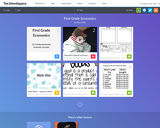
Students will learn about the concepts of work, choice, spend, earn, and save.
- Provider:
- CSCOPE
- Date Added:
- 04/11/2017

Students will learn about the concepts of work, choice, spend, earn, and save.

In this lesson, students will identify a variety of jobs that people perform and determine for each job whether it provides a service or good and explain the importance of having businesses that provide services and goods in their community.

In this lesson, students learn to identify the difference between things they want and items they need for survival.

In this lesson, students will identify ideas for earning money and learn that money is a reward for working.

This first-grade inquiry features an investigation of economic decision making through the context of how families manage their money. In examining the costs and benefits associated with making decisions about spending and saving money, students should be able to develop an argument with evidence to answer the compelling question “What choices do we make with our money?â€

In this lesson, students will demonstrate that spending is exchanging money for goods and services, compare the price of a good at more than one store, recognize that prices are what people pay for goods and services, and identify that all consumers have limited budgets and must make choices.

In this lesson, students will explore simple economic concepts such as: goods, services, wages, and expenses.

This chapter examines the important distinction between wants and needs.

This unit teaches students basic economic concepts with the use of a video, interactive website, and activity pages.

The Gingerbread Market is Project-Based Learning for Social Studies Economics. Students learn what it means to be a consumer and a producer by supplying goods and services for a donation. All earnings are donated to the Cystic Fibrosis Foundation and the American Cancer Society.

Students listen to the book The Goat in the Rug, about a Navajo weaver named Glenmae who uses mohair from her goat Geraldine and a number of resources and intermediate goods to make a traditional Navajo rug. The students are placed in groups to learn about productive resources and intermediate goods. The students play a matching game and make posters to classify the natural resources, human resources, capital resources, and intermediate goods used in the story to produce the rug

Summarize the various ways in which people earn and use money for goods and services.

In this lesson, students use data from visuals and graphs to make inferences about places. Students discover that human characteristics of places depend upon the natural resources found in environment in their community. Natural resources also affect jobs that are available in the area as well.

In this lesson, students will review the concepts of needs and wants. Through the use of fables, fairytales, and other literature, students learn about the differences between needs and wants.
They examine the reasons why people can’t have everything they want and consider that individuals who want more than they can have often requires the person to make choices.

In this lesson, students learn how the concept of scarcity applies to choices families make every day. Students identify choices families make because of the lack of resources and because of wanting more than one can have.

In this lesson, students will learn about the concepts of work, choice, spend, earn, and save.

In this lesson, the book, Sheep in a Shop, by Nancy Shaw, is used to teach students about choice, making decisions, trade, and the barter system.

In this lesson, the book, A Dollar for Penny, by Dr. Julie Glass, is used to teach students about producers, consumers, and price.

In this lesson, the book, Charlie Needs a Cloak, by Tommie dePaola, is used to teach students about productive resources, labor and income.

In this lesson, the book, The Case of the Shruken Allowance, by Joanne Rockin, is used to teach students about labor, earn income, saving, creating budgets, and equivalent amounts of money. Students complete worksheets on labor and budgets.